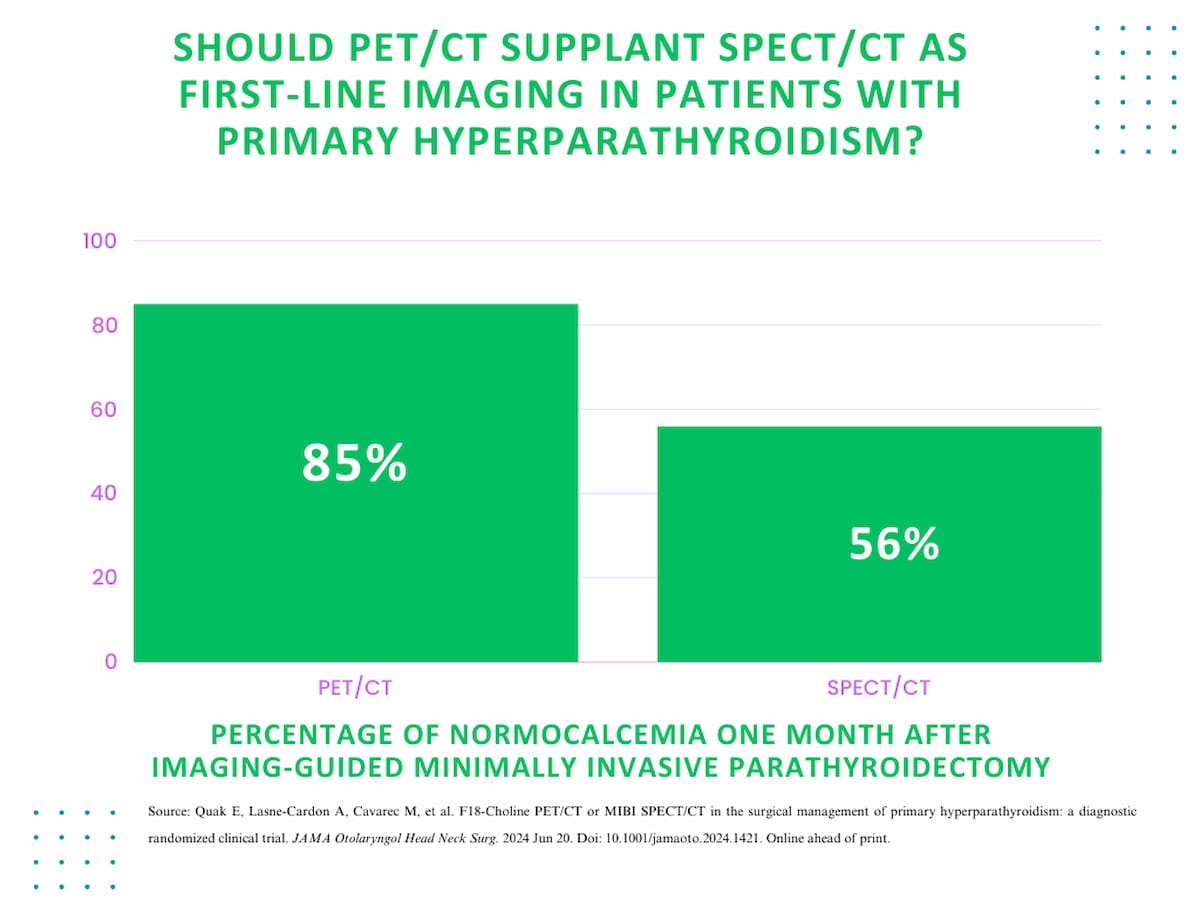Results from a new randomized clinical trial (RCT) suggest that first-line imaging with positron emission tomography/computed tomography (PET/CT) offers superior results to single photon emission computed tomography/computed tomography (SPECT/CT) for assessing parathyroid adenomas (PTAs) in patients with primary hyperparathyroidism (PHPT).
For the multicenter RCT, recently published in JAMA Otolaryngology-Head & Neck Surgery, researchers compared first-line imaging with F18-choline PET/CT to Tc99m-sestaMIBI (MIBI) SPECT/CT in 57 patients (mean age of 62.8) with PHPT who required a minimally invasive parathyroidectomy (MIP) procedure. According to the study, 29 patients had F18-choline PET/CT and 28 patients had (MIBI) SPECT/CT. The researchers noted that crossover imaging was performed when there were negative or inconclusive results with initial imaging.
The researchers found that F18-choline PET/CT offered a 19 percent higher sensitivity than MIBI SPECT/CT for PTAs (82 percent vs. 63 percent). At one month after the MIP procedure guided with F18-choline PET/CT, 85 percent of patients (23/27) had normocalcemia in comparison to 56 percent of patients who had MIP guidance with MIBI SPECT/CT, according to the study authors.
“The findings of this clinical trial show that (F18-choline PET/CT) can be used as a first-line imaging technique for preoperative PTA localization in the surgical management of PHPT, thereby suitably replacing MIBI SPECT/CT. We observed a superior rate of successful MIP leading to normocalcemia 1 month after surgery for (F18-choline PET/CT) compared to MIBI1, a finding that can be explained by the higher sensitivity of (F18-choline PET/CT) vs MIB1 (SPECT/CT),” wrote lead study author Elske Quak, M.D., who is affiliated with the Department of Nuclear Medicine and Thyroid Unit at Centre Francois Baclesse in Caen, France, and colleagues.
Noting that F18-choline PET/CT is currently not cleared for parathyroid imaging, the researchers also pointed out that the agent is more expensive and has less availability than MIBI SPECT/CT.
Three Key Takeaways
1) Higher sensitivity and improved outcomes with normocalcemia. F18-choline PET/CT demonstrated a higher sensitivity (82 percent vs. 63 percent) for detecting parathyroid adenomas compared to MIBI SPECT/CT. This led to a higher rate of normocalcemia (85 percent vs. 56 percent) one month after minimally invasive parathyroidectomy.
2) Improved imaging characteristics. F18-choline PET/CT offers superior spatial resolution, quicker study protocols due to rapid biokinetics, and lower ionizing radiation exposure compared to MIBI SPECT/CT, making it a potentially more effective imaging modality for preoperative localization of parathyroid adenomas.
3) Current limitations and considerations. Despite its advantages, F18-choline PET/CT is not yet cleared for parathyroid imaging, is more expensive, and less widely available than MIBI SPECT/CT.
However, the study authors also noted three key benefits of F18-choline PET/CT in patients with PHPT.
“The advantages of (F18-choline PET/CT) over MIBI SPECT/CT imaging are the rapid biokinetics of the tracer with a shorter study protocol, superior spatial resolution allowing the detection of small adenomas, and lower exposure of patients to ionizing radiation,” emphasized Quak and colleagues.
The researchers added there were no adverse events related to imaging in the study.
(Editor’s note: For related content, see “Can a CT-Based Radiomics Model Bolster Detection of Malignant Thyroid Nodules?,” “What New Research Reveals About ChatGPT and Ultrasound Detection of Thyroid Nodules” and “A Closer Look at Ultrasound and MRI Alternatives for Head and Neck Imaging.”)
In regard to study limitations, the researchers noted the lack of post-op follow-up after six months and the small size of the cohort. The study authors added that comparison of FCH PET/CT to other imaging techniques, such as magnetic resonance imaging (MRI) or four-dimensional contrast-enhanced CT, was beyond the scope of this research.
